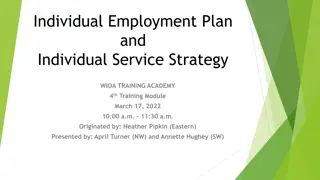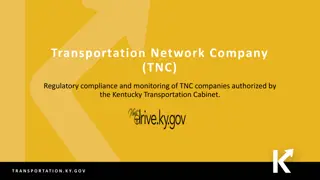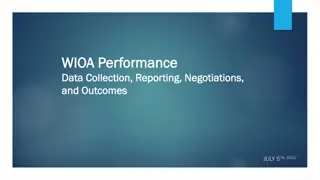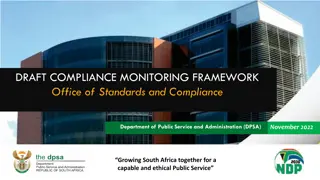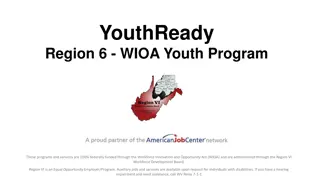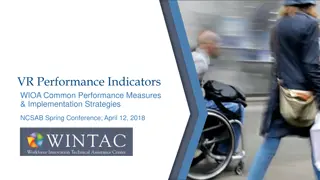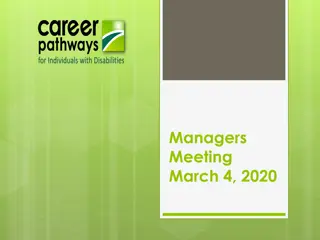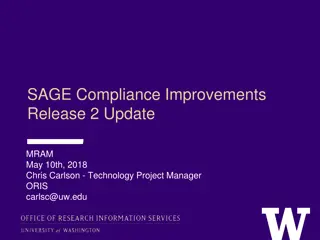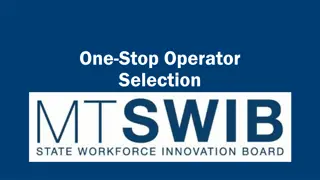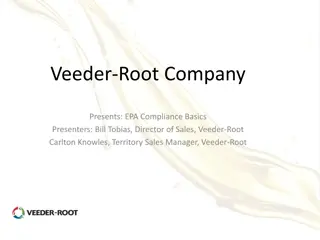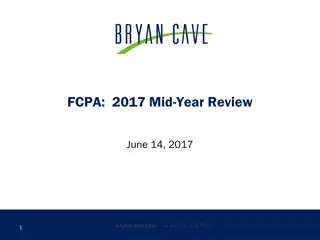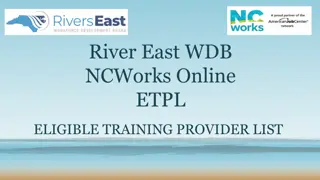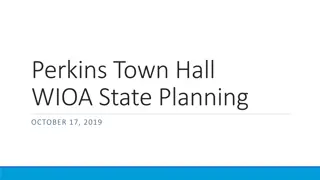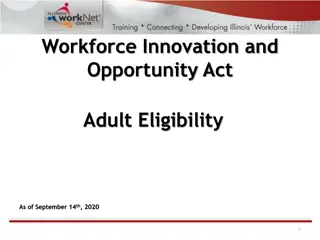WIOA Monitoring, Compliance, and Policy Mid-Year Update
This update by Nicholas Bishop covers the importance of monitoring and compliance in WIOA programs. It includes discussions on policy implementation, the monitoring process, and the significance of efficient and effective resource allocation under the WIOA guidelines. The session emphasizes the need for continuous improvement, transparency, and communication in workforce development efforts.
Download Presentation

Please find below an Image/Link to download the presentation.
The content on the website is provided AS IS for your information and personal use only. It may not be sold, licensed, or shared on other websites without obtaining consent from the author.If you encounter any issues during the download, it is possible that the publisher has removed the file from their server.
You are allowed to download the files provided on this website for personal or commercial use, subject to the condition that they are used lawfully. All files are the property of their respective owners.
The content on the website is provided AS IS for your information and personal use only. It may not be sold, licensed, or shared on other websites without obtaining consent from the author.
E N D
Presentation Transcript
WIOA Monitoring, Compliance, and Policy Mid Program Year Update Presented By: Nicholas Bishop Director of Compliance and Policy TDLWD Workforce Services Division Nicholas.Bishop@tn.gov (615) 741-0286
Session Agenda: Not a tutorial session. Several meetings with LWDA directors on policy implementation during 2017 (halftime adjustments). Monitoring Process Review of FAQ/ Re-occurring policy issues Goals and items to put on your radar for 2nd half. Q&A at the end
Locate the Policies: Where do you go to review the WIOA technical assistance? 66 different pieces of policy (SWDB), guidance's (TA), memo s (TA), and program manuals.
Why Is Monitoring Important? WIOA compliance, program errors, allowable expenditures, etc: Grantees, LWDBs, and CLEOs don t know what they don t know they may not think they have a problem (transparency, communication, and tools for measuring results are needed) Data alone can t tell the whole story observations, conversation, and analysis are needed It serves as opportunity to provide resources and make adjustments, or ask for help It drives continuous improvement monitoring is not strictly related to
Efficient/Effective vs. Allowable/Non-Allowable WIOA calls for building bridges in education, workforce development, development, but and economic
Efficient/Effective vs. Allowable/Non-Allowable Avoid building bridges to nowhere: Often times in government, a project or expenditure may be allowable, but how often do we audit to determine if it was a good idea or best use of resources? Where the Law Gives us License to Do What is Best for Our Communities: WIOA gives us license to do the work we have wanted to do and is best for our communities, but have been seemingly restricted by former WIA Policy. Innovation to support change and continuous improvement are key components of WIOA; these activities are allowable and encouraged. Provisions within the law ensure that States and the Department of Labor work together to share promising and proven practices; to evaluate and disseminate information regarding such practices; and to identify and commission research to address knowledge gaps. http://www.nawb.org/documents/Publications/WIOA_Overview.pdf
Local Accountability WIOA empowers local workforce boards and county mayors to determine how WIOA resources are utilized in their local communities. However, empowerment comes with responsibility and accountability. LWDBs and CLEOs must ensure WIOA resources are being properly utilized at the local level, as well as guarantee proper engagement and workforce development, economic development, and education system as a whole. How does your LWDB and CLEO monitor and assess whether or not the local system is operating in this capacity? participation within the
The Short and Skinny of it The CLEO and LWDB members must set forth the vision, goals, and strategy. The CLEO and LWDB members are the decision makers. The LWDB staff oversees the execution of the visions/goals and adhere to/help develop the strategy. The Fiscal Agent pays the bills and holds the funds but only acts based on directions/authorizations from the CLEO and LWDB. The One-Stop Operator oversees the functionality of the service delivery system and AJC (and may also deliver services) based on the priorities that have been set by CLEO/LWDB.
The Short and Skinny of it. At the direction of the LWDB, the LWDB staff should monitor (monitoring doesn t mean managing/controlling/etc.) the One-Stop Operator and service providers. The LWDB staff should report the success, obstacles, failures, results, etc. of the system back to the LWDB members and CLEO. The CLEO and LWDB members develop a process for lines of communication and collecting/analyzing the data. Based on the data and communications, CLEO and LWDB members make the decisions on how to keep moving the LWDA forward to meet the needs of the community while remaining compliant with WIOA regulations and state policies.
Know Your Role! Understand the difference between the roles of LWDB members, LWDB staff, Fiscal Agent, and Operators/Service Providers.
Know Your Role! Who makes decisions on awarding contracts? Who manages the contracts? Who monitors the deliverables within the contract? Who measures the success of the contract? Who decides where the AJC s and access points should be? Who manages the daily functions, planning, scheduling, etc. of the AJC? Who sets forth the strategy for the LWDA? Who determines the deliverables in the contracts?
Know Your Role on the Team "Teamwork is the ability to work together toward a common vision. The ability to direct individual accomplishments organizational objectives. It is the fuel that allows common people to attain uncommon results. Andrew Carnegie toward
Monitoring the One-Stop Operator Performance Regular evaluation of the OSO and re-competition of operators every 4 years (or more often if SWB or LWDB elects to do so) What criteria is your LWDB using to evaluate the OSO performance? Who is tasked with conducting the monitoring? How often is the process conducted? Are you monitoring the OSO and service provider contracts to ensure deliverables are being executed? How is this process being formalized and reported out at the LWDB meetings, to the CLEO, and to TDLWD?
Executing the Local and Regional Plans How do you conduct monitoring to ensure the activities outlined in your local and regional plans are being executed? How are you evaluating the outcomes/results of the activities in the plans to determine if the LWDA is being efficient and effective? How do you collect data in order to make adjustments and improvements to your local and regional plans? How do all of the parties within the plan collectively measure the success of the plan? Has the OSO reviewed the Local/Regional Plans?
Execution of SWDB Policies and Guidance Conduct an inventory and create a directory of LWDB policies. See TDLWD example (WIOA Technical Assistance Webpage) Local Board must/shall/should develop a policy Upcoming TDLWD audit/review of local policies You have a policy, but is it efficient and effective? What is the LWDB s state/federal requirements and implementing local policy? How are you developing regionally minded policies? process for reviewing *** Reminder on Local Policy Review Due Jan 17th***
Local Board Required Policy Example Excerpt from LWDA Supportive Service Guidance Limits to the Amount or Duration of Supportive Services: The following must be outlined in the local policy developed for each LWDA: oLWDBs may establish limits on the provision of supportive services or provide the One-Stop operator with the authority to establish limits, including a maximum amount of funding and maximum length of time for supportive services to be available to participants. o Procedures should also be established to allow One-Stop operators to grant exceptions to the limits established. oThe appropriate documentation required from the participant for each of the supportive services provided. oDetermine how payments will be disbursed. oProcedure in place documenting the steps to be taken by staff when supportive services are needed. WIOA Supportive Services Guidance
Fiscal Monitoring Forty percent (40%) minimum participant cost rate (LWDB vs regional) Eighty percent (80%) obligation rate How are you measuring these rates? If your CLEO calls in the next 10 minutes and inquires on these rates, can you tell them the rate in a matter of seconds?
State Policies with Fiscal Impact Transfer Authority Re-allotment funds Minimum Rate One Stop Certification One-Stop MOU/Infrastructure Guidance AJC Individual Account Use Consolidated Business Grants Cost Classification Incumbent Worker Training (IWT) Grants LWDA support Services One-Stop Design & Delivery System of Formula X Allowable and Unallowable costs WIOA Formula Allocation Methodology Property Management Co-Enrollment of AJC customers CLEO Roles and Responsibility One Stop Procurement Guidelines WIOA Youth Program Local Governance Participant Cost Training
Vital Data Signs of an LWDA Budget (including 80% obligation rate and 40% minimum participant cost rate Progress of the goals in local and regional plans Alignment of resources based on customer needs and utilizations VOS Greeter Foot traffic vs. online engagement Geographical barriers Partners Labor Market Information (LMI) Business and Employer Service Statistics Outreach to New Business and Users
Vital Data Signs of an LWDA Progress on reaching those with Barriers (i.e. Target Groups) Needs of the Community Partnership Building Career Pathways Performance Dashboard Efficiency and Effectiveness of American Job Center System
Data-Driven Evaluations W. Edwards Deming-creator of the standards used in the U.S. Census and Bureau of Labor Stastics data reports.
Vital Data Signs and Dashboards At any given time, the LWDB and CLEO should be able to view the status of these vital signs and other signs deemed important. Be on the lookout for the local performance dashboard from our performance and reporting unit.
Common Risks/Issues WIOA Firewall Structure Duties and Controls Process One-Stop Operator Function Contractual Issues Between LWDB and OSO One-Stop Design Policy and Alignment of Resources Co-Enrollments
Firewall Structures Single entity serving multiple functions 679.400 Who are the staff to the Local Workforce Development Board and what is their role? (a) WIOA sec. 107(f) grants Local WDBs authority to hire a director and other staff to assist in carrying out the functions of the Local WDB. (b) Local WDBs must establish and apply a set of qualifications for the position of director that ensures the individual selected has the requisite knowledge, skills, and abilities to meet identified benchmarks and to assist in carrying out the functions of the Local WDB. (c) The Local WDB director and staff must be subject to the limitations on the payment of salary and bonuses described in WIOA sec. 194(15). (d) In general, Local WDB staff only may assist the Local WDB fulfill the required functions at WIOA sec. 107(d). (e) Should the WDB select an entity to staff the WDB that provides additional workforce functions beyond the functions described at WIOA sec. 107(d), such an entity is required to enter into a written agreement with the Local WDB and chief elected official(s) to clarify their roles and responsibilities as required by 679.430.
Functional LWDA Chart: Single Entity as OSO/Service Provider Chief Local Elected Official Local Board TDLWD Regional Directors Fiscal Agent Local Board Staff Firewall One-Stop Operator AJC Site Leads Partner Agency Leads Required Career Service State Merit Staff Contracted Service Providers
Supervision Firewall (Duties and Controls) When a single entity is serving as both One-Stop Operator (OSO) and provider of career services in the AJC, you must have a supervision firewall between the two units. The career service staff should not have the same personnel supervisor as the OSO. Don t confuse functional supervision with personnel supervision. The OSO is the functional leader/supervisor in the AJC. See Training and Employment Guidance Letter (TEGL) 15-16 alignment/functional
Duties and Controls Monitoring (If the OSO and Career Service Provider are the same entity, the Board Staff, rather than the OSO, must monitor the Career Service Provider). 10% admin (overall)
Role of a One-Stop Operator The operator is charged with coordinating the service delivery among partner agencies in One-Stop Centers. Duties include but are not limited to: Managing daily operations in coordination with WIOA fiscal agent for the lease, utilities and other activities to support the center Managing partner responsibilities Memorandum of Understanding (MOU) among partners Managing hours of operation Managing services for individuals and businesses Ensure that basic services such are available (orientations, labor market information, resource room) defined in the
Role of One-Stop Operator Implementing of Local Workforce Development Board Policy Adhering to all federal and state regulations and policies Reporting to Local Workforce Development Board on operations, performance and continuous improvement recommendations
Role of One-Stop Operator The One-Stop Operator cannot assist in the development, preparation and submission of local plans. They cannot manage or assist in the competitive process for selecting operators or select or terminate One-Stop Operator, Career Services and Youth Providers. Local Workforce Development Boards are responsible performance measures and budgets. for the negotiated
The OSO is the Team Captain ( Functional vs. Personnel)
Who Can Be the One-Stop Operator? A public, private, or non-profit organization A consortium, which must include at least three (3) required WIOA partners An institution of higher education A State Wagner-Peyser Employment Agency A community based, non- profit organization Interested Organizations such as local Chamber of Commerce, business or labor organization
Who Can Be the One-Stop Operator Please note that the law makes no mention of the OSO being limited to a single individual. Do you consider the OSO to be an entity that performs a function, or a sole individual ?
Monitoring the OSO Contract Are you monitoring the deliverables in the OSO contract? Q&A
One-Stop Delivery & Design Policy The assigning title I staff to an AJC, and being available full-time during the posted work hours. difference between present and
One-Stop Delivery & Design Policy As outlined in section A. (1) (Comprehensive Centers) of the One-Stop Delivery and Design policy, Title I and Wagner-Peyser Act sec. 7(a) services must be present and available full- time during posted work hours with access to each partner program and its services.This includes having program staff and at minimum one Title I staff physically present at the one-stop; trained to provide information to customers about the programs, services, and activities; and providing technology- based support such as a phone for job seekers, use of a fax machine to transmit paperwork, or access to a computer in the resource room that can provide a direct connection to program information or services. Required Partners must be available on- site or through electronic or referral means.
One-Stop Delivery & Design Policy If only 1 or 2 title I staff are assigned to an AJC, what happens when they are sick, at meetings, on vacation, etc.? Are you adequately staffed at the One-Stop Operator level? Do you consider the One-Stop Operator as a singular person or an entity with multiple people delivering the One-Stop Operator function? Review the contracts, resources provided for the purpose of staffing AJC s and providing services.
One-Stop Design-Resource Alignment During the last quarter, the most visited AJC in 3 LWDA s was not a comprehensive AJC. How do you align your resources? What factors do you determine on where staff will be placed? What factors are measured? Who makes the decisions? Who takes part in the discussions? VOS Greeter
Choose Wisely Orderly Chaos
Supportive Services Policy Burdensome requirements per local policy. Co-enrollment issues (RESEA, SNAP, TRADE) Transportation and support services are keeping people from training/education. (Complete TN report) https://static1.squarespace.com/static/56cf531db6aa 6036fa14e1f8/t/59484f881b631b8487c2a72e/149791 1185461/Complete+Tennessee_Room+To+Grow- Regional+Perspectives.pdf
Co-Enrollments Automatic Co-Enrollment: WIOA programs that target similar demographics should coenrollment. One such example is Reemployment Services and Eligibility Assessments (RESEA), and dislocated worker programs. Other programs that may be paired could include Supplemental Nutrition Employment and Training (SNAP E&T), TRADE, Temporary Assistance for Needy Families (TANF), Adult Education (AE), Dislocated Worker Programs and Youth Programs. https://www.tn.gov/content/dam/tn/workforce/documents/P rogramManagement/WFS_Policy_-_TN_WIOA_17-7-_Co- Enrollment_.pdf necessitate automatic Assistance Program
Co-Enrollment Statistics 12,863 unique individuals entered the AJC s last quarter indicating they were RESEA participants or there for UI assistance. 99% 12,863 are eligible dislocated workers. How many total WIOA enrollments during the same quarter? 374 probability those
Co-Enrollment Statistics Show the report from Justin 50% Referred 25% Enrolled
Co-Enrollment SNAP Stats Last Quarter 331 have volunteered for SNAP E&T 225 have been referred to Title I 111 were co-enrolled with Title I
Connecting the Dots Not assigning enough title I staff to an AJC can lead to low WIOA enrollments, lack of access to services, etc. Low WIOA enrollments/lack of access to services, leads to obstacles with meeting the 40% minimum participant cost rate and 80 % obligation rate. Failure to meet these rates results in the LWDA having funds de-obligated.
Connecting the Dots Funds de-obligated means area citizens lack access to services. Lack of services/assistance with training, supportive services, etc. can make or break the success of job seekers. Lack of education/training/employment/support services leads to dependency on public assistance, inability to provide for family, prevents self-sustainability, creates public burdens, etc.


